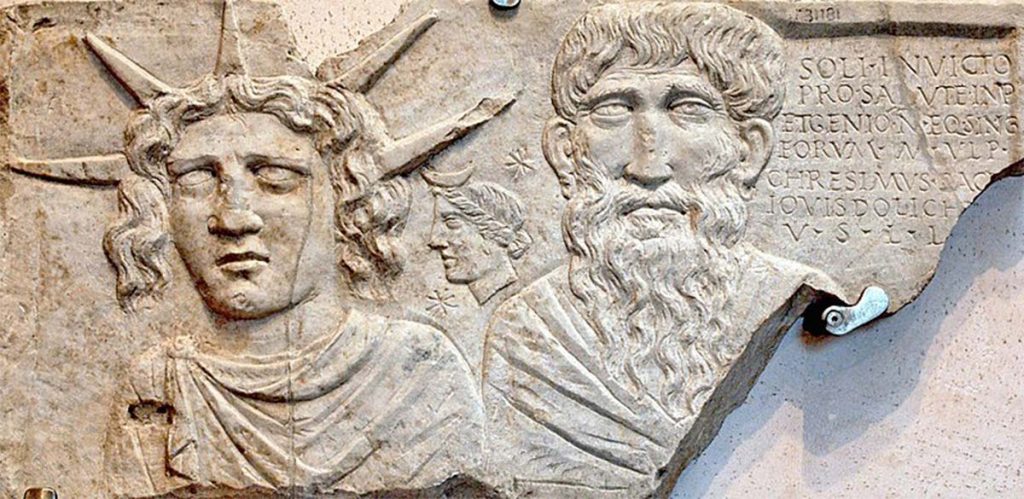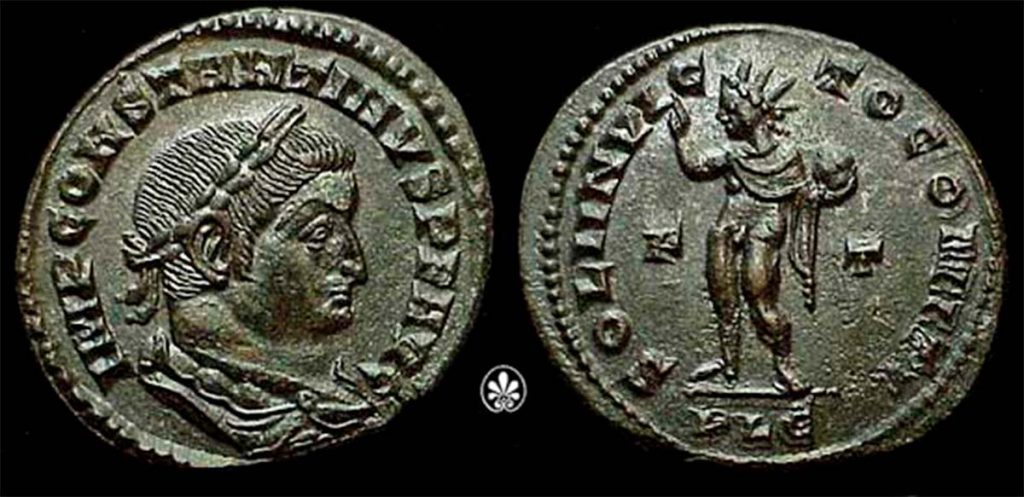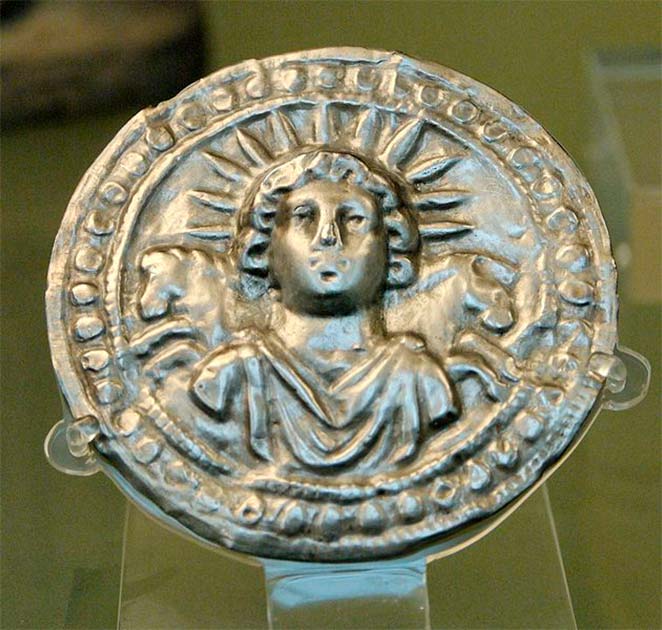Sol Invictus, also known as the invincible sun or the unconquered sun, was the official sun god of the late Roman Empire. He was a later version of the classic sun god Sol, and he was dusted off and revived as “Invictus” in AD 274 under the emperor Aurelian.
Aurelian attempted to use Invictus Sol as his chief god of the Empire. The main feast and festival day of Sol Invictus was on the 25th of December which was the date of the winter solstice on the Roman Calendar. It was called the Dies Natalis Solis Invicti (Birthday of the Invincible Sun).
Sol became increasingly important to emperors after Aurelian’s reign, and he was prominent right the way through to Constantine’s conversion to Christianity. The last inscription that has been found to date discussing Sol Invictus is dated to AD 387 but a 5th-century Augustine preached against them showing that they still held some sway nearly 100 years later.
In recent times, the academic community has become divided on this subject. The traditional argument suggests that Sol Invictus was the second of two different Roman sun gods: Sol Indiges was the first.

He was a minor god whose following petered out in the 1st century. Invictus came later and was promoted initially under Elagabalus but without much success. The revisionist view however believes that the worship of Sol was constant.
Invictus
Invictus is an epithet, an adjective usually referring to a quality, that has been seen to be used by many Roman gods. These included Jupiter, Hercules, Apollo, and Mars.
It was used as early as the 3rd century BC. The earliest use of this Epithet for Sol has been recorded in AD 158. Within this period, there is also a 2nd-century Roman ornamental disc that refers to Sol as Invictus (Inventori Lucis Soli Invicto Augusto: “I glorify the unconquerable sun, the creator of light”) and also an inscription found on a portico in Rome within the Trastevere area.
This portico and the inscription was created by Gaius Iulius Anicetus. The link with Augustus reveals a link with the imperial cult as well as a link to the Mithraic mysteries. However, there is little tangible evidence to suggest a pattern or reason for this.
Other Emperors favored association with this god. In the works of the Historia Augusta, a work not dissimilar to Suetonius’ Life of the Twelve Caesars, Elagabalus is the teenage heir to the Severan line and adopted the name of the Sol Invictus from Emesa, taking it to Rome. When he arrived in Rome, Elagabalus refused to follow Rome’s traditional deities and promoted Sol as the most powerful and respectable god to follow. Unfortunately, this ended with his murder in 222.

Then there is the family of the Emperor Aurelian and the Emperor himself, both of which have been associated with the cult of Sol for many years. Aurelian reformed the cult of Sol after many victories in the Eastern Roman Empire.
It was through him that Sol Invictus became a premier divinity within Rome. Previously priests of Sol had only tended to the lower ranks of Roman Society, after Aurelian’s support grew, the priests were promoted to “pontifices”, the highest-ranking priest in the Empire.
Every Pontifex of Sol was a member of the senatorial elite, a high and influential rank within Roman society. Aurelian himself built a temple for Sol in 274 on the 25th of December, and ordained that games should be held in Sol’s honor every four years.
By the time that Constantine became Emperor, Sol Invictus had begun to be portrayed on coinage throughout the empire. Many of these coins featured phrases that claimed the Unconquered Sun was a companion of the emperor.
This particular style was used by Constantine repeatedly, as the Emperor found associating himself with a god to be very useful to his personal reputation and the cult of personality which grew up around him. On the Arch of Constantine, there are three statuettes of Sol Invictus, and the coinage that represented them both was used at least until 325/6 AD.
On the 7th of March 321, Constantine decreed Sunday as the day of rest as it was the Dies Solis,the Day of the Sun. It was clearly so important to Constantine that he aligned his triumphal arch with the colossal statue of Sol next to the Colosseum, so that it formed his backdrop whenever his formal procession approached from the arch.
Legacy on Christianity
There is a widely held belief that the Christian church chose to make Christmas Day, as it is celebrated today, on the 25th of December because it was Jesus Christ’s Birthday (Dies Natalis Christi). It does seem an odd coincidence however that this was also the date that Aurelian had decreed as Sol’s Day of celebration.
- Lupercalia and the Brothers of the Wolf: a Forgotten Roman Festival
- Royal David’s City: A Post-Christmas Conundrum
It has been argued that the church hoped to use this date to link Jesus to the Sun God. This worked in several ways.
The Roman Empire tended to replace existing holidays with their own. This meant that any conquered people would slowly integrate with any new pieces of information.
However, in addition to this, the early church referred to Jesus as the “Sun of Righteousness” and that spelling is both correct and relevant. A Christian treatise from the early 4th century claims that Jesus was born on the 25th of December which was the same day that the Romans celebrated the Birthday of the Unconquered.

This created a great narrative, and a consistency in worship from the earlier cult of Sol Invictus to the later cult of Jesus Christ. This theory, which reappeared in a 12th-century Syrian source as well, makes a lot of sense: easy to introduce a new god into your Empire if the forms of worship remain familiar.
It is not the only possibility however. Another theory suggests that the date for Christmas was calculated by choosing a date nine months after Christ’s conception on March 25th. This was also the date of the Roman Spring Equinox which again tied in nicely with the current religious system.
Then there is the mosaic found in the tomb of the Julii (a leading family of Rome who count Julius Caesar and his nephew Augustus amongst their number) which has been interpreted to be a version of Christ on a chariot. The second-century philosopher Clement of Alexandria claimed that the scene had Christ driving his chariot across the sky much like a certain sun god would.
Sol Invictus
From a humble deity to the prime god of the Roman Empire, the Sun God Sol transformed over the millennium that he was popular. It is not hard to see that if Sol was as widely recognized and popular in the 4th century, the church would have sought to use his feast day as that of Jesus’s Birthday and of Christmas as the world knows it today.
Top Image: Sol Invictus became a central religious figure in the Roman pantheon, his iconography borrowed by several emperors including Constantine. Source: Chrixxi / Adobe Stock.
By Kurt Readman